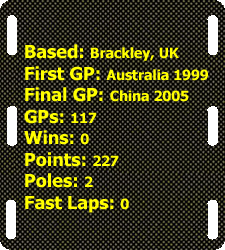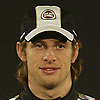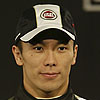|
British American Racing appeared in 1999. The team had been assembled by Jacques Villeneuve's friend and manager, Craig Pollack, and the three main elements were Villeneuve himself, as number one driver and share holder, technical input from Reynard Motorsports and massive sponsorship from BAT - British American Tobacco. In 1995, Villeneuve had won the Indycar Championship, and the Indianapolis 500, in a Reynard with sponsorship from Player's, a BAT brand.
Reynard had become the world's most profitable maker of production racing cars, but a pervious attempt to join Formula One, 1990/91, had come close, very close, to bankrupting the company. In the light of that experience, Reynard's involvement in the new team had certain limits. Its chief designer, and member of the board, Malcolm Oastler, headed the technical team of BAR, but he recruited his team from the entire industry. His task was to assemble the best possible team without affecting Reynard's core business.
As an initial move, BAR cast around to buy an existing team. Several options were explored, Benetton among them, and finally a deal was done with Tyrrell. During 1998, Team Tyrrell was used as a transitional exercise while a new state-of-art facility was prepared at Brackley Northamptonshire England, where Reynard already had its composites division.
Supertec supplied the paid-for engines for 1999 and these were developments of Renault units though, without full works backing, they were not on a par with the best opposition and throughout 1999 slipped further behind.
The fact that the team did not have the sharpest power units does not, however, explain its dire performance in its debut year. When the team was announced, there were confident predictions of maintaining Reynard's tradition of winning first time out in every new category it tackled. This prediction rebounded on the team as, in a miserable year, it failed to score a single Championship point. More often than not, the cars failed to finish for a wide variety of niggling reasons.
The team responded by sacking several senior people, but not really key personnel, and there was a certain amount of the washing of dirty linen in public.
Despite a dismal showing, on and off the track, BAR still managed, by mid-season, to secure a deal with Honda to supply works engines in 2000. This stroke surprised everyone, not least Eddie Jordan whose team, with Mugen-Honda engines, both won races and finished third in the Constructors' Championship. In private, Eddie was spitting razor blades, but he was superb in public.
Part of Honda's decision was due to Honda's perception of Jacques Villeneuve. The Japanese have always an attitude towards individual drivers, which appears odd to Anglo Saxons.
Despite the promises 2001 was another disappointing season especially when one compares the Brackley outfit's budget with that of Sauber. However, Honda have remained loyal, and despite what might be said in public, much to the detriment of Jordan.
The news that CEO Craig Pollock had been unceremoniously dumped the day before the 2002 launch sent shockwaves down the pitlane. Thus far Villeneuve has kept quiet and concentrated on the job in hand, however there are many who believe that the 1997 world champion will quit at the end of the season, if not a lot earlier.
2002 was a transient season for BAR, out with the old and in with the new. In the first few months of his 'reign' new boss David Richards appeared to sit back and watch developments, then suddenly he struck. A significant proportion of the workforce was culled while technical director Malcolm Oastler and designer Andy Green jumped ship before they were pushed.
BAR's problems were many, politics, a powerful yet wholly unreliable engine, money and an uncompetitive chassis.
The team didn't score its first points until round ten of the championship at Silverstone, following dreadful reliability, especially for Panis in the opening rounds.
Despite speculation to the contrary Jacques Villeneuve remained with the Brackley out for 2003, joined by British F1 pin-up Jenson Button. If Richards' signing of Button was meant to unsettle Villeneuve it clearly worked, for the Canadian began a ludicrous war of words with the youngster, using the media to liken the former Williams and Renault driver to a boy band, describing him as unproven. For the most part Button ignored the attacks, which did little for the team and far less Villeneuve.
Geoff Willis' first car for the team was clearly a step forward. Though hardly radical, the 005 was a good, fairly competitive car, the influence of Willis' apprenticeship under Patrick Head clear for all to see.
Although the Honda engines continued to be problematic, there were times when there was clearly light at the end of the tunnel, and the Japanese manufacturer insists that 2004 will be the make or break season. That said the 2003 unit was heavy, had a high centre of gravity and had a tendency to 'detonate' at the drop of a button. No pun intended.
Villeneuve suffered terribly, with poor reliability throughout the season, adding to the Canadian's clear frustration with the team on which he'd gambled his career. Furthermore, with his five-year contract due to end at season's end there were concerns as to whether Richards wanted him out and indeed if JV wanted to stay.
For the most part the politics dominated the season and at times it seemed the media was being used by various interested parties to wage war on one another. Weeks before the Japanese GP Takuma Sato revealed that he would replace Villeneuve at Suzuka, a claim hurriedly denied by all the parties concerned. Needless to say that is exactly what happened, the Canadian turning his back on the team, and possibly F1.
Looking ahead to 2004, Willis described the 006 as another major step forward, and in many ways that is exactly what it proved to be. Pre-season testing was extremely promising, with the BAR establishing a number of new lap records, and for once the team carried the good form on into the season.
Following Villeneuve's departure, Button was promoted to the role of team leader, with many claiming that the season would be the making or breaking of the young Englishman. Takuma Sato was brought in as number two, while Anthony Davidson took over as test and third driver.
It was soon clear that BAR finally appeared to have got its act together. The car was good, while Jenson Button stepped up to the plate and confidently led his team. Third places in Malaysia and Bahrain - Button's first trip to the podium - were followed by second place in San Marino and Monaco. In all, Button visited the podium on ten occasions, leading his team to runner-up spot in the constructors' championship.
Sato also performed well, however the Japanese driver's aggressive style, certainly compared to Button's smooth, Prost-like, approach, cost him a significantly high number of engine failures.
Special mention must be made of test driver Anthony Davidson, who set a blistering pace in the Friday morning sessions, topping the timesheets on almost every occasion. His hard work throughout the season surely made a significant contribution to the team's excellent showing.
Late in the season, as BAR attempted to fend off the challenge for runner-up spot, the team recruited former Arrows driver Enrique Bernoldi. Clearly, the Brackley outfit was pulling out all the stops.
Although the BAR 006 was a fine car, the team's efforts were helped by the failure of its rivals to mount a sustainable challenge. McLaren wasn't competitive until the end of the latter stages of the season, while Renault, despite a strong start, lost direction.
However, there was plenty of action off-track also.
Firstly the team became involved in a legal tug-of-war with WilliamsF1, after Jenson Button took advantage of a supposed loophole in his contract and signed up for the Grove outfit for 2005. It was a long drawn out and messy affair, with the Contract Recognition Board eventually finding in favour of BAR.
Then, in mid-November, Honda purchased a 45% stake in the team, and at the same time revealed that it would not be renewing David Richards' contract with the team. As Richards' left Brackley, allegedly with a compensation package worth $15m, managing director Nick Fry was promoted to the role of team principal.
Launching the 2005 contender, Geoff Willis claims that the 007 was another significant step forward, and following the success of 2004 who doubted him?
Button had certainly proven himself, though the jury was still out on Sato. Meanwhile, Anthony Davidson was retained as test driver, as was Bernoldi.
It was a dreadful season for the Brackley outfit, the team hitting absolute rock bottom when it was disqualified from the San Marino Grand Prix and excluded from the next two races after it was adjudged to have used an illegal fuel tank. At the halfway stage in the championship BAR, which had finished runner-up in the 2004 Constructors' Championship, had not scored a single point, and by season end it was fighting Red Bull for sixth.
From the outset, the 007 lacked pace, and throughout the season, despite some sterling work by the aero department, it was a question of catch up. A hopeless task at the best of times.
Despite the despair of the first half of the season, Button strung a series of points scoring finishes together, taking points in ten consecutive races, enough to salvage some pride for the Brackley outfit.
Furthermore, there was another tug-of-war between BAR and WilliamsF1 over the English driver's services, Button now having decided that his future lay in Brackley. Eventually a deal was struck, lots of money changed hands, and Williams signed Nico Rosberg.
However, hanging like a black cloud over the entire season was the fuel tank saga, never mind that many of BAR's rivals were thought to be running similar systems.
It was inevitable - given the changes the sport was undergoing - not to mention the anti-tobacco legislation being introduced worldwide, that eventually Honda would buy out British American Tobacco's remaining shares. And that is exactly what happened in late 2005.
In 2006, Honda would return to F1 as a fully fledged F1 team, with BAR consigned to history, much like Minardi, Jordan, Prost…
As for BAR, it started as a dream, and for many of those involved it became something of a nightmare.
From the outset, with its name, dual livery, 'tradition of excellence' motto, right through to the fuel tank saga of 2005, there was controversy. Other than that glorious summer of 2004, and a few other (rare) moments of inspiration many will be only to happy to see the end of the BAR era.
|


























